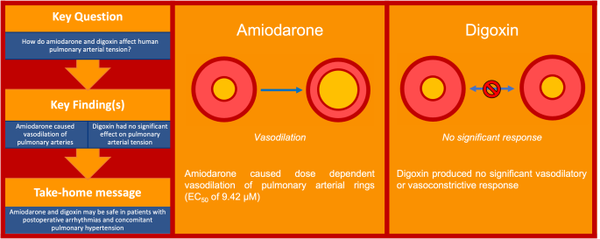-
Home
-
About JCTR
-
Gold Open Access
-
Issues
-
Editorial board
-
Author guidelines
-
Publication fees
-
Online first
-
Special issues
-
News
-
Publication ethics
-
Partners
-
Submit your manuscript
-
Submit your review report
-
Editorial Office
-

This work is licensed under a Creative Commons Attribution-NonCommercial 4.0 International License. ISSN print: 2382-6533 ISSN online: 2424-810X
Volume 8 Issue 4
The impact of antiarrhythmics on human pulmonary arteries: Ex-vivo characterisation
Rishab Makam*, Nayla Tajmohamed, Syed Qadri, Mubarak Chaudhry, Michael Cowen, Mahmoud Loubani, Azar Hussain
Makam et al. J Clin Transl Res 2022; 8(4):8
Published online: July 25, 2022
Abstract
Background & aim: The safety and efficacy of the anti-arrhythmic agents, amiodarone and digoxin, in patients with pulmonary hypertension is not described well in literature although their use is common practice. Our study aims to investigate the effect of these drugs on pulmonary arteries which may have implications for their use in patients with pulmonary hypertension.
Methods: Human pulmonary arteries were obtained from consenting patients undergoing lobectomies. Arterials rings (N=40 from 10 patients) were dissected form the tissue and mounted onto a multiwire myograph. The rings were preconstricted using prostaglandin F2α before the addition of additive dilutions of amiodarone and digoxin. Finally, the reagents were washed out and the arterial rings’ viability was confirmed using acetylcholine and potassium chloride.
Results: Amiodarone had a slightly vasodilatory effect on the arterial rings, whereas digoxin had a relatively neutral effect. Amiodarone caused the greatest vasodilatory response at 100 μM with an active tension of -0.494 gf with an EC50 of 9.42 μM. Digoxin produced no significant vasodilatory or vasoconstrictive response.
Conclusions: This study demonstrated the ex vivo effects of amiodarone and digoxin on human pulmonary arterial tension. The results of the study showed that neither amiodarone nor digoxin had any vasoconstrictive effects. Amiodarone also exhibited vasodilatory properties and therefore may be used preferentially as it could help reduce the impact of PH. However, more studies need to be conducted before we can confirm the safety of these drugs.
Relevance for patients: The ambivalence surrounding treatment of postoperative arrhythmias in patients with pulmonary hypertension results is a significant disparity between individual cases. Our study takes the first step in elucidating which drugs may be a safer treatment for patients with the aim to resolve the doubts clinicians may have about using these treatments. The principal goal of our work is to ensure that we are providing patients with the most effective and, more importantly, safest treatment.

DOI: http://dx.doi.org/10.18053/jctres.08.202204.008
Author affiliation
1. The Hull York Medical School, University of Hull, Hull, United Kingdom
2. Department of Cardiothoracic Surgery, Castle Hill Hospital, Hull, United Kingdom
*Corresponding author
Rishab Makam
Allam Medical Building, Department of Medicine, The Hull York Medical School, University of Hull
Hull, United Kingdom, HU6 7RU
Tel: +44 7393634620
Email: makam.rishab@gmail.com
Handling editor:
Michal Heger
Department of Pharmaceutics, Utrecht University, the Netherlands
Department of Pharmaceutics, Jiaxing University Medical College, Zhejiang, China
Downloads
Full text PDF
Supplementary data (47.3 KB)
Review process jctres.08.202204.008.pdf (138.1 KB)

